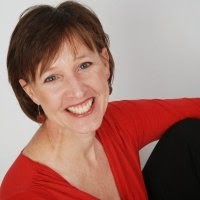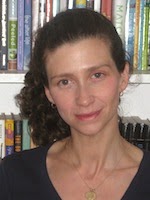Hundreds of writers gathered at the Society of Children’s Book Writers and Illustrators (SCBWI) Summer Conference in Los Angeles last weekend.
The annual “Editor’s Panel” featured a star-studded collection of editors, including Dutton Children’s Books publisher Julie Strauss-Gabel–she’s worked with Ally Condie, John Green and John Grisham, among many others. Strauss-Gabel snapped that photograph of her view from stage during the panel. GalleyCat was there, gathering advice for aspiring writers…
1. You need to send the manuscript to the right editor. Strauss-Gabel explained: “I’m very attentive to fit both the imprint and if it is a good manuscript for me. We mean it when we say ‘this is not the right manuscript for me.’ I know another editor could bring something to that manuscript that I couldn’t.” She advised writers to read an editor’s body of work and understand what kind of books they love.
(more…)
New Career Opportunities Daily: The best jobs in media.
 |
| Mary Lee Donovan |
Mary Lee starts off with this caveat: "We never set out to make Judy Moody a series, which is probably good and bad to hear."
Once it took hold, though, some choices in the writing and pacing of the books were very deliberate, but in the beginning that was not the goal. Megan and Mary Lee tell us about
Judy Moody's Origin Story:
 |
| Megan McDonald |
Megan's early works were not funny, her parents passed away when Megan was 30 and for a long time Megan's voice was fairly quiet and serious because she was in such a dark place. But in an effort to capture family memories, she grew up with four older sisters, Megan had been writing down all of the crazy, outrageous, hilarious things that had happened in her family.
When Megan and Mary met at a conference, they had an instant connection and Megan asked Mary Lee: "I have all these stories about my family that I don't know what to do with, but I want to do something, do you think you could look at them?"
Mary Lee chimes in, "Let me add, you are so funny, I can't believe you didn't start writing funny. I could see you had this incredible energy and sense of humor... I just knew, how can I work with this person, how can I work with this material. It was already episodic, which was great for chapter books, but we needed it to add up to something more."
From there Megan and Mary Lee worked on adding that something more and eventually Megan had a full novel.
Megan's original Judy Moody book was much, much longer and not illustrated. Mary Lee calls cutting over half of the original book like having a sour dough starter, the cuts could be used—would be used—for a next book. (Actually, those cuts were not used until book 3.)
Megan probably calls cutting over half the book mildly terrifying. But after the designer and then Peter H. Reynolds added in so many superb visual elements, Megan was in love with the book's everything and on board with all of the cutting.
Megan and Mary Lee share a bit more about the journey of Judy Moody and then give the audience some tips on creating a series. Here is one tip below, some questions you should ask yourself
after you write that first, great book.
Are we doing a Book 2? Or are we doing a sequel?
Can things be episodic? Or are you going to wrap things up in the book's entire world within the next one or two books?
 |
| Mary Lee Donovan |
Mary Lee Donovan is editorial director at Candlewick Press, where she's worked for 23 wonderful years, following a 7-year stint at Houghton Mifflin as well as time as a bookseller at The Children's Bookshop when she was getting her MA in Children's Literature from Simmons College in Boston.
 |
| Julie Strauss-Gabel |
Her titles include the Newbery Award-winning GOOD MASTERS, SWEET LADIES by Laura Amy Schlitz, Megan McDonald's Judy Moody and Stink series, and the Caldecott honor book JOURNEY by Aaron Becker. They publish everything from picture books up, and have a relationship with Walker Books in the UK.
Julie Strauss-Gabel is the vice president and publisher of Dutton Children's Books, an imprint of Penguin Young Readers Group. She publishes about 9 or 10 middle grade and young adult titles each year. She just acquired her fourth memoir and is looking for those, as well. Before coming to Dutton in 2002, she worked at Hyperon Books for Children and Clarion Books. Her authors include Ally Condie, Adam Gitdwitz, John Green, Stephanie Perkins, Lauren Myracle, John Grisham, Andrew Smith, and more.
The topic of the editors' panel was titled "3+3: Three Things Your Book Should Include and Three Things to Avoid." Lin Oliver moderated, and questions in bold are hers.
What's on good thing to see in a manuscript?
Mary Lee Donovan: "I remember hearing voice. What do they mean by that? Voice is something you bring to your manuscript automatically. You want to make sure you are writing as you. Don't try to imitate, or echo another writer or style. If you are writing authentically, you are writing in your voice."
When you get something fresh or exciting, it's like meeting a new person who enchants or astonishes you, she said.
She recommends writers take their time when it comes to deciding which editors to send a book to. The Internet has a lot of information on editors and their lists that are very useful.
Julie Strauss-Gabel: "Voice is the No. 1 thing I have written down. That you have heard that across the whole table is an extraordinarily significant piece of information. I'm also very attentive to fit, for my imprint and for myself as an editor. I can look at a manuscript and very quickly know if it's good and if it's a good fit for me."
She is looking for something that she can fall in love with and champion for many, many years. She recommends writers read editors' lists, not looking at just the surface things. It's important to remember that you can't please all the people all the time, which is why you shouldn't write to a general audience.
What grieves you when a manuscript comes in?Julie Strauss-Gabel: "If I don't get engaged, if I don't see the voice, if it's very pedestrian, I'm out."
Mary Lee Donovan: "Don't impart wisdom."







